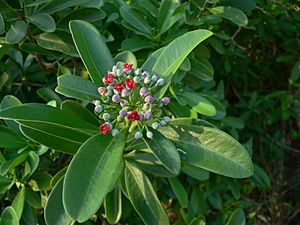Canella facts for kids
Quick facts for kids Canella |
|
|---|---|
 |
|
| Scientific classification | |
| Genus: |
Canella
|
| Species: |
winterana
|
| Synonyms | |
|
Canella alba Murray |
|
Canella is a special kind of tree. It is the only species in its group, called a monospecific genus. This tree is known as Canella winterana.
You can find Canella trees growing naturally in the Caribbean region. This includes places from the Florida Keys all the way to Barbados. The bark of the Canella tree is used as a spice. It tastes a bit like cinnamon. Because of this, people often call it cinnamon bark, wild cinnamon, or white cinnamon.
Contents
About the Canella Tree
The wood from the Canella tree is very strong and heavy. It is also quite hard. The wood is a dark red-brown color. The outer part of the wood, called sapwood, is lighter. It can be light brown or yellow.
In Florida, Canella trees usually grow to be about 25 to 30 feet tall. Their trunks can be eight to 10 inches wide. In the mountains of Jamaica, they can grow even taller, sometimes up to 50 feet!
Leaves and Flowers
The branches of the Canella tree spread out. They form a nice, rounded top. The bark on the trunk is light gray. It is about an eighth of an inch thick. The inner bark is pale yellow and smells nice.
The leaves of the Canella tree are shaped like an oval. They are about 3.5 to 5 inches long and 1.5 to 2 inches wide. They are a bright, shiny deep green color. The flowers bloom in the autumn.
Fruit of the Canella Tree
The fruit of the Canella tree ripens in March and April. When it is ready, it turns a bright crimson red. The fruit is soft and fleshy. Many birds enjoy eating these fruits.
Why is it Called Canella?
The name Canella comes from a Latin word, canna. This word means "a cane or reed." It was first used for the bark of another tree, called cassia. Cassia bark curls up like a roll when it dries. This reminded people of a cane. Later, the name was given to this West Indian tree.
The group, or genus, Canella was officially named in 1756 by Patrick Browne. The second part of the tree's name, winterana, comes from a time when people confused it with another tree called Winter's bark. That tree was named after William Winter.
Where Canella Grows
Canella trees are found in many places. They are common in the Florida Keys. J. L. Blodgett was the first person to find them there. These trees often grow in the shade of bigger trees in thick forests.
Canella was one of the first American trees that Europeans noticed. It was mentioned in many old travel stories about America.
We found there a tree whose leaf had the finest smell of cloves that I have ever met with; it was like a laurel leaf, but not so large: but I think it was a species of laurel.
– Diego Álvarez Chanca, January 1494
The Canella tree is very pretty. It has white bark, bright green leaves, and red fruit. This makes it one of the most beautiful smaller trees in south Florida. It was brought to England in 1738. Philip Miller was the first person to grow it in Europe.

